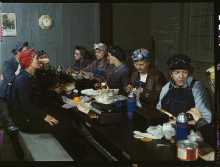Today, we feel a disconnection from our not-too-distant past perhaps because of the color of the photographs. We have changed our viewing lens from black-and-white to color, and sometimes, when we look at black-and-white photos from the 1930’s and ‘40’s, it’s easy to think of them as historical, something dead and something gone. Perhaps that’s what’s so jarring about the Denver Post’s online gallery Captured: American in Color from 1939-1943. The photographs were some of the only color photographs taken during the Great Depression.
The color photographs were originally shot by the Farm Security Administration and the Office of War Information to demonstrate the effects of the Depression on rural and small town populations. The photographs now belong to the Library of Congress, and were displayed for the public in a 2006 exhibit called Bound for Glory: American in Color.
The photographs are fantastic. They show a number of different populations: poor, migrant workers in their jean overalls and shift dresses, female workers at plants during World War II, poor blacks in urban and rural areas, and soldiers in their uniforms and planes. Although we’ve seen many colorized images, these are particularly striking since they were shot originally in color. There’s no guessing about the colors that the images in the photos were.
Some of the most striking photographs feature their subjects staring into the camera. The first photograph in the series features a couple named Faro and Doris Caudill from Pie Hill, New Mexico staring into the lens, arms crossed, with a sky storming behind them. The photo was taken in 1940. Another shot from Pie Hill features a family of seven sitting in their home, which seems to have been constructed from cardboard and plywood.
Particularly intriguing are the series of photos taken in Washington, D.C., mostly because of their contrast with the other mostly-rural snapshots. One photo features a bunch of young children bundled up in coats using pieces of as toy guns. Another photograph shows a little white girl in a red dress sitting on the stoop of a grocery store as a little black boy and his mother look on it her. The obvious separation between the races—the little girl sits with her head hung and the little boy’s mother pulls him from her—is particularly poignant.
What photographs are your favorites? Do you feel more connected to these photos than other historical depictions?
